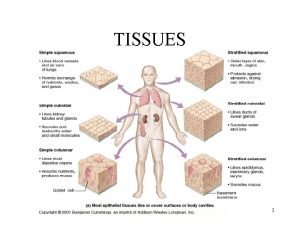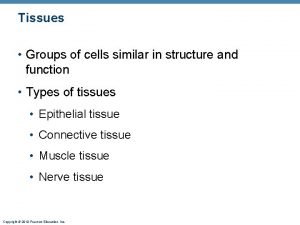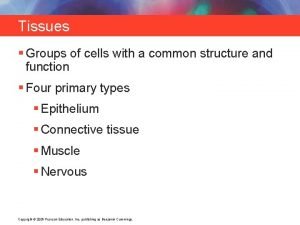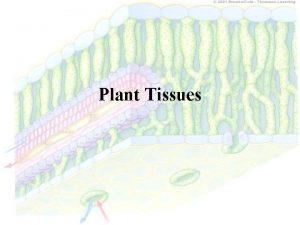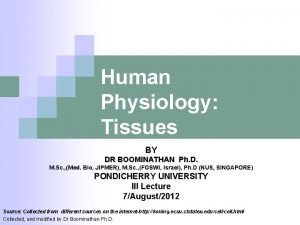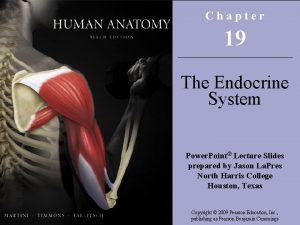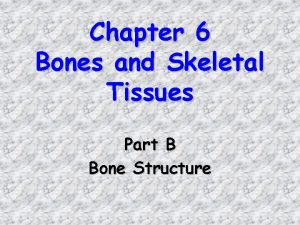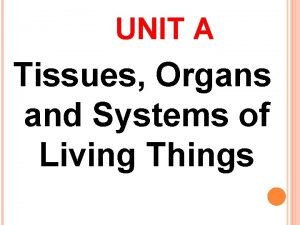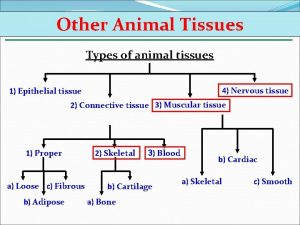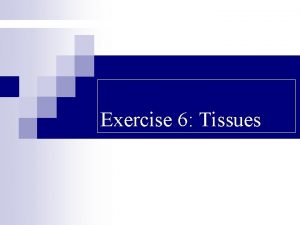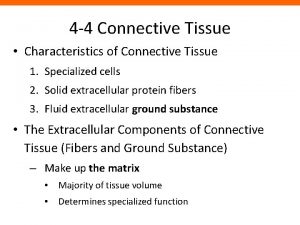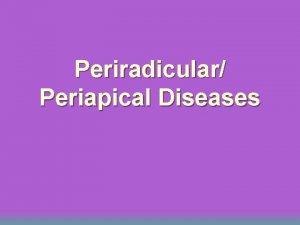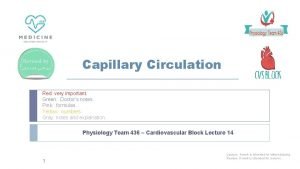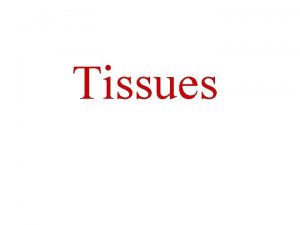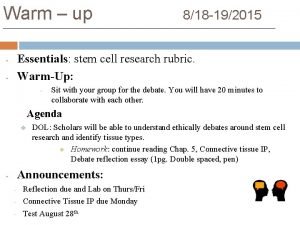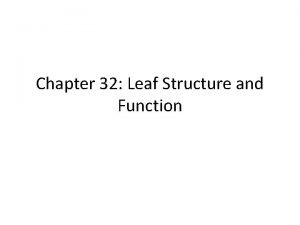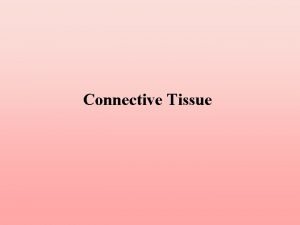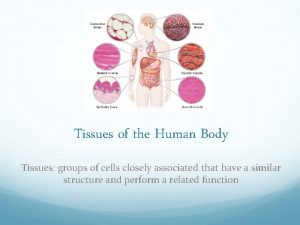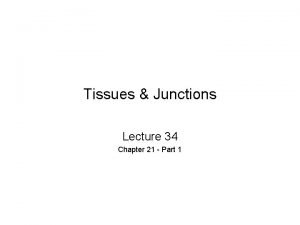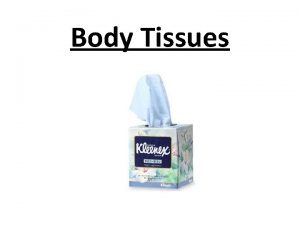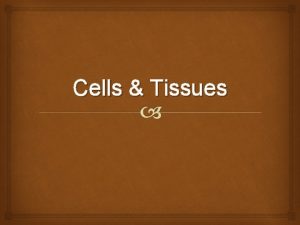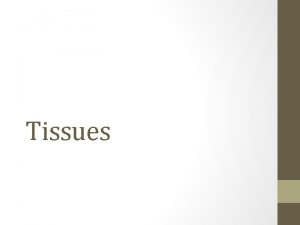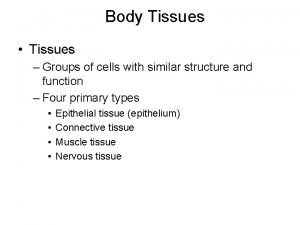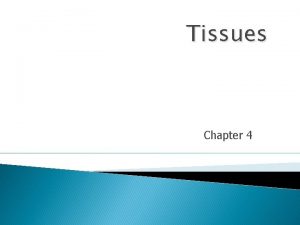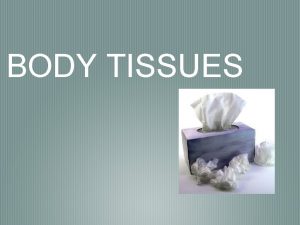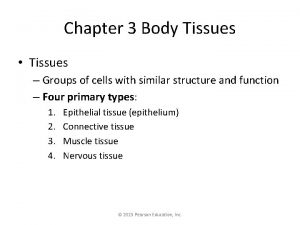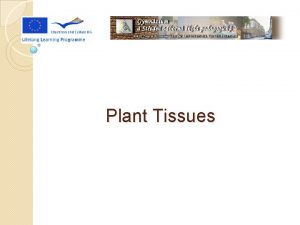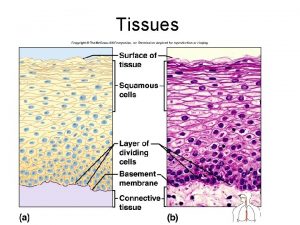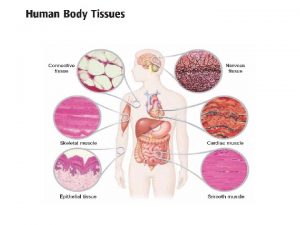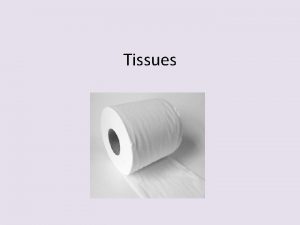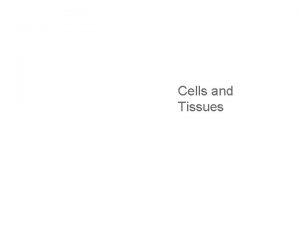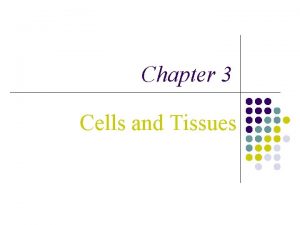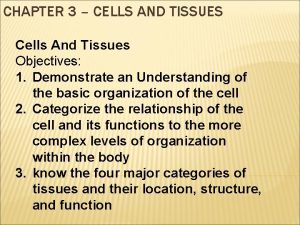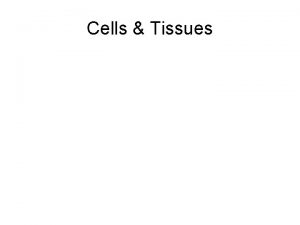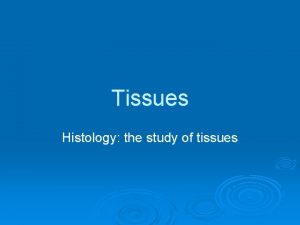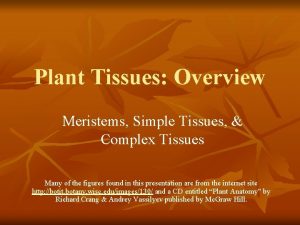Tissues Tissues o Groups of cells that share































































- Slides: 63

Tissues

Tissues o Groups of cells that share a similar function are called tissues. There are many types of tissues that are designed to perform a variety of functions.


Epithelial Tissues o Characteristics: n n Sheets of cells that line the body’s surface or a body cavity. Surface of cell exhibits polar properties. Exposed surface called apical surface. Anchored surface is called basal surface. Most apical surfaces have microvilli.

n Designed to fit close together. Includes tight junctions and desmosomes. Tight junctions keep proteins in the apical region from diffusing to the basal region, thus maintaining polarity.

n n n Epithelial sheets are usually supported by connective tissues. Avascular (no blood vessels) but innervated (infused with nerve tissues). Highly regenerative.

Types of Epithelium o Simple: Single cell layer. o Stratified: more than one cell layer.

Squamous o Flattened scale-like cells.

Cuboidal o Cube shaped, as wide as it is tall.

Columnar o Long Column shaped cells.

Simple Squamous Epithelium o Structure: o Single layer of flattened cells with disc shaped central nucleus and sparse cytoplasm. o Function: o Allows passage of materials by diffusion and filtration in sites where protection is not important, secretes lubricating substances into serosae.

Simple Squamous Epithelium

Simple Cuboidal Epithelium o Structure: o Single layer of cube like cells with large spherical central nucleus. o Function: o Secretion and absorption.

Simple Cuboidal Epithelium

Simple Columnar Epithelium o Structure: o Single layer of tall cells with round and oval nuclei; some cells bear cilia; layer may contain mucus-secreting unicellular glands. o Function: o Absorption; secretion of mucus, enzymes, and other substances, ciliated types propel muscles and sometimes reproductive cells, through ciliary action.

Simple Columnar Epithelium

Pseudostratified Columnar Epithelium o Structure: o Single layer of cells of differing heights. Some not reaching the surface. Nuclei seen at different levels; may contain mucus-secreting cells and bear cilia. o Function: o Secretion, particularly of mucus; propulsion of mucus by ciliary action.


Stratified Squamous Epithelium o Structure: o Thick membrane composed of several cell layers; basal cells are cuboidal or columnar and metabolically active; surface cells are flattened (squamous). Squamous cells shouldn’t just be found, usually always anchored to other cell types. o Function: o Protects underlying tissue areas subject to abrasion.


Stratified columnar & stratified cuboidal epithelium o Structure: o Thick multi-layered tissues. Usually junctions between other epithelium. Rare in the human body. o Function: o supports for other tissues. Usually found in ducts or glands.

o Columnar Cuboidal

Transitional Epithelium o Structure: o Looks like stratified squamous and stratified cuboidal. Basal cells cuboidal or columnar; surface cells dome shaped or squamous like. o Function: o Stretches readily and permits distension of urinary organ by contained urine.


Glandular Epithelia o Glands- one or more cells that secrete or make a particular product. Things secreted are called secretions. Usually always aqueous.

Endocrine Glands o Endocrine glands produce hormones. o There are too many to go into detail on right now because they all vary in size, shape, and function. o (whole chapter devoted to this later on)

Exocrine glands o Numerous and vary in function. o All secrete on the surface of the skin or in a body cavity. o We will discuss these more when we cover integument.

Connective tissue o Most abundant of the tissues. o Four main classes of connective tissues: n n Blood Connective tissue proper Cartilage Bone tissue

Characteristics of Connective Tissue o Common origin: all come from mesinchyme (an embryonic tissue) o Degrees of vascularity: range from avascular (cartiladge), to highly vascularized (bone) o Extracellular matrix: nonliving tissues form the extracellular matrix. Can bear pressure, withstand tension, and handle abuse.

Functions of connective tissue o Functions: n n Binding and support Protection Insulation Transportation (blood)

Structural Elements of Connective tissue o Ground substance: fills gaps b/w cells and contains fibers. Made of interstitial fluid, cell adhesion proteins and proteoglycans.

o Fibers: provide support. n Collagen fibers- made of collagen, provide strength. n Elastic Fibers: made of protein elastin, rubbery, and allows connective tissues to snap back to place after tension is relieved in the tissue. n Reticular fibers: collagen like fibers that form networks that then form around blood vessels.

o Cells: n n Fibroblasts-forms connective tissue proper Chondroblasts- cartilage Osteoblasts- forms bone cells Hematopeotic stem cells- undifferentiated blood blast cell.

Connective tissue proper: loose connective tissue, areolar o Structure: o Gel-like matrix with all three fiber types; cells: fibroblasts, macrophages, mast cells, and some white blood cells. o Function: o Wraps and cushions organs; its macrophages phagocytize bacteria; plays important role in inflammation; holds and conveys tissue fluid.


Connective tissue proper: loose connective tissue, adipose o Structure: o Matrix as in areolar, but very sparse; closely packed adipocytes, or fat cells, have nucleus pushed to the side by large fat droplet. o Function: o Provides reserve food fuel; insulates against heat loss; supports and protects organs.


Connective tissue proper: loose connective tissue, reticular o Structure: o Network of reticular fibers in a typical loose ground substance; reticular cells lie on the network. o Function: o Fibers form a soft internal skeleton (stroma) that supports other cell types including white blood cells, mast cells, and macrophages.


Connective tissue proper: dense connective tissue, dense regular o Structure: o Primarily parallel collagen fibers; a few elastic fibers; major cell type is the fibroblast. o Function: o Attaches muscles to bones or to muscles; attaches bones to bones; withstands great tensile strength when pulling force applied in one direction.


Connective tissue proper: dense connective tissue, dense irregular o Structure: o Primarily irregularly arranged collagen fibers; some elastic fibers; major cell type is the fibroblast. o Function: o Able to withstand tension exerted in many directions; provide structural strength.


Connective tissue proper: dense connective tissue, elastic o Structure o Dense irregular connective tissue containing a high proportion of elastic fibers. o Function o Allows recoil of tissue following stretching; maintains pulsatile flow of blood through arteries; aids passive recoil of lungs following respiration.


Hyaline Cartilage o Structure: o Amorphus but firm matrix; collagen fibers form an imperceptible (hard to perceive) network; chondroblasts produce the matrix and when mature, will lie in lacunae. o Function: o Support and reinforce, resist compression.


Elastic Cartilage o Structure: o Like hyaline cartilage, but more elastic. o Function: o Maintains structure while allowing great flexibility. (like your ear)


Fibrocartilage o Structure: o Matrix similar to but less firm than hyaline cartilage. Has thick collagen fibers. o Function: o Tensile strength with the ability to absorb compressive shock.


Bone o Structure: o Hard calcified matrix containing many collagen fibers; osteocytes lie in lacunae. Very well vascularized. o Function: Support Protection Movement Storage Blood cell formation


Blood o Structure: o Red and white blood cells in a plasma. o Function: o Transport of respiratory gases, wastes, and nutrients.


Nervous tissue o Structure: o Contains a cell body with a nucleus core, with a tail called a dendrite. o Function: o Transmit electrical signals from sensory receptors and to effectors which control their activity.


Skeletal Muscle o Structure: o Long cyllindrical, multinucleate cells, obvious striations. o Function: o Voluntary movement; facial expressions


Cardiac muscle o Structure: o Branching striated, generally uninucleate that lock at special junctions. o Function: o As it contracts, it propels blood into the circulation; involuntary control.


Smooth muscle o Structure: o Spindle shaped cells w/central nuclei. No striations; cells arranged closely to form sheets. o Function: o Propels substances or objects along internal passageways; Involuntary control.

 Body tissues chapter 3 cells and tissues
Body tissues chapter 3 cells and tissues Eisonophil
Eisonophil Body tissues chapter 3 cells and tissues
Body tissues chapter 3 cells and tissues Stained cheek cell
Stained cheek cell The 4 tissues
The 4 tissues Tissues are groups of similar cells working together to
Tissues are groups of similar cells working together to A group of cells similar in structure and function
A group of cells similar in structure and function Tissues are groups of similar cells working together to
Tissues are groups of similar cells working together to Which part of the cell contains genetic material
Which part of the cell contains genetic material Chapter 3 cells and tissues figure 3-1
Chapter 3 cells and tissues figure 3-1 Smooth endoplasmic
Smooth endoplasmic Division of anatomy
Division of anatomy Sau thất bại ở hồ điển triệt
Sau thất bại ở hồ điển triệt Block xoang nhĩ
Block xoang nhĩ Con hãy đưa tay khi thấy người vấp ngã
Con hãy đưa tay khi thấy người vấp ngã Thơ thất ngôn tứ tuyệt đường luật
Thơ thất ngôn tứ tuyệt đường luật Thơ thất ngôn tứ tuyệt đường luật
Thơ thất ngôn tứ tuyệt đường luật Tôn thất thuyết là ai
Tôn thất thuyết là ai Walmart thất bại ở nhật
Walmart thất bại ở nhật Gây tê cơ vuông thắt lưng
Gây tê cơ vuông thắt lưng Phân độ lown ngoại tâm thu
Phân độ lown ngoại tâm thu Tìm vết của mặt phẳng
Tìm vết của mặt phẳng Loosely organized groups who share interests and activities
Loosely organized groups who share interests and activities How are ethnic groups and religious groups related
How are ethnic groups and religious groups related Dense regular connective
Dense regular connective Muscle tissue parts
Muscle tissue parts Cuál es la diferencia entre la célula animal y vegetal
Cuál es la diferencia entre la célula animal y vegetal Thyroid parafollicular cells
Thyroid parafollicular cells Chlorocruorin
Chlorocruorin The organelle trail
The organelle trail Are red blood cells prokaryotic or eukaryotic
Are red blood cells prokaryotic or eukaryotic Eukarya
Eukarya Gametic cells vs somatic cells
Gametic cells vs somatic cells Masses of cells form and steal nutrients from healthy cells
Masses of cells form and steal nutrients from healthy cells Pns water view position
Pns water view position Nondisjunction in meiosis
Nondisjunction in meiosis Plant cell animal cell venn diagram
Plant cell animal cell venn diagram Label
Label Proximal convoluted tubule
Proximal convoluted tubule Somatic vs germ cells
Somatic vs germ cells Cells cells they're made of organelles meme
Cells cells they're made of organelles meme Prokaryotes vs eukaryotes venn diagram
Prokaryotes vs eukaryotes venn diagram Angiosperm leaf cross section
Angiosperm leaf cross section Tissues definition
Tissues definition Pearson endocrine system
Pearson endocrine system Chapter 6 bones and skeletal tissues
Chapter 6 bones and skeletal tissues Hannah campion
Hannah campion Vertex presentation images
Vertex presentation images Connective tissue bone
Connective tissue bone Cell membrane function
Cell membrane function Tissues in circulatory system
Tissues in circulatory system Types of tissues
Types of tissues What is this tissue
What is this tissue Connective tissue characteristics
Connective tissue characteristics What are periradicular tissues
What are periradicular tissues Acute and chronic apical periodontitis
Acute and chronic apical periodontitis Gas exchange between tissues and capillaries
Gas exchange between tissues and capillaries What are the four major tissue types
What are the four major tissue types Types of tissues
Types of tissues Leaf tissues
Leaf tissues Four basic tissues
Four basic tissues Collagen location in body
Collagen location in body What is tissue?
What is tissue? Simple squamous epithelium
Simple squamous epithelium





